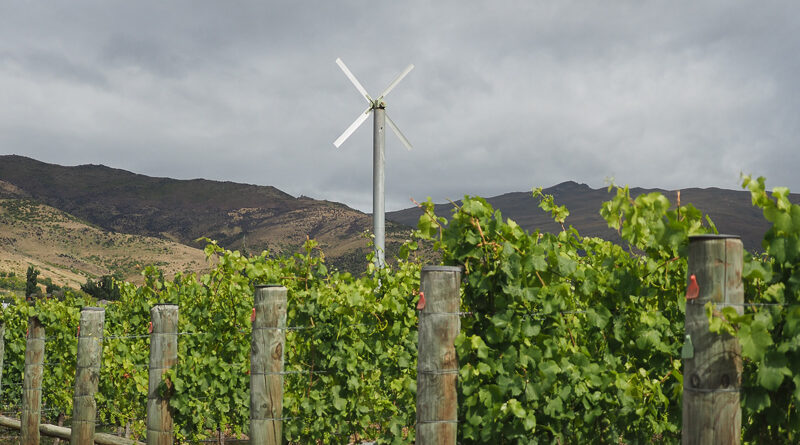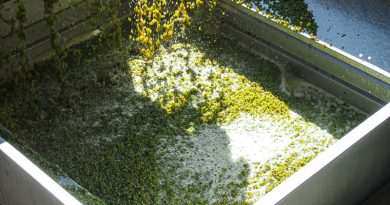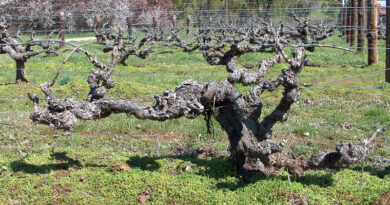Frosts and freezing: a look at the science
Frost is an increasing problem in the wine world, with vineyards across many regions experiencing worse frosts as a result of climate chaos. Jamie Goode looks at the preventive measures that can be used to minimise damage, and explores the science of frosts and freezing in viticulture.
As I write, winegrowers in France and northern Italy are currently going through one of the worst spring frost episodes in recent memory. After a balmy end to March with temperatures on the 20s C (70s F) dormancy finished and vines started budding. This was then followed by a number of extremely cold nights as things went back to winter temperatures, with many regions experiencing bud-killing low temperatures. The extent of the damage is still unclear, but it is significant, and across many regions – even some where spring frosts are not usually an issue. For France, this is the worst frost since 1947. And this is following on from pretty severe frosts in recent years that have targeted regions more specifically. The big concern is that global warming (or climate chaos, however you want to describe it) is worsening frost risk because vines get going earlier in the season. This has certainly been the case in New Zealand’s Marlborough region, where frost fighting that has always been part of the wine scene there has intensified in recent years.
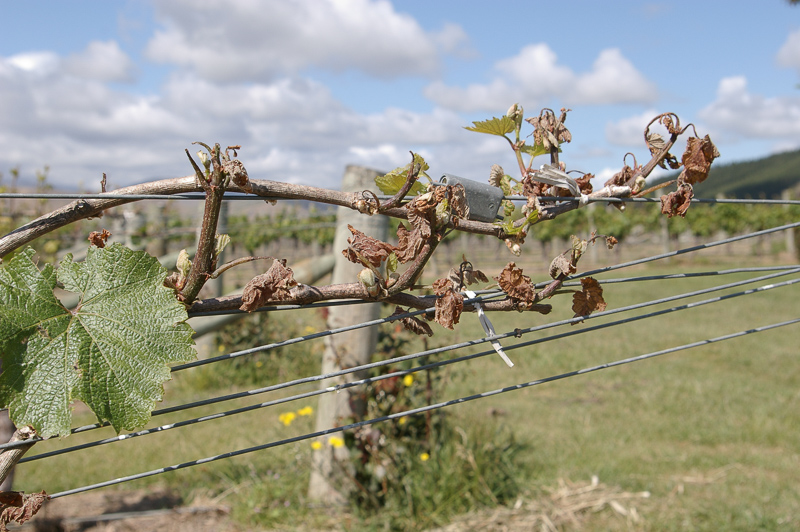
When a vine is dormant it can survive very low temperatures. Just how low depends on a number of factors. One is the path to dormancy: if temperatures drop slowly, the vine becomes cold hardy to a greater extent than if they suddenly dip very low. And different species and varieties also differ in their cold hardiness. Native American and Asian vine species have adapted to very cold winters and are pretty hardy, down to -30 C. Hybrids of Vitis vinifera often have this cold hardy trait. Vitis vinifera is less hardy, and below -18 C it can accumulate winter damage.
Winter kill

Canada’s wine regions illustrate the importance of winter hardiness. In the Niagara peninsular the lake effect stops winter temperatures plummeting too far, and so vinifera can be grown here without too much of a problem as long as it is near the lake, which acts as a sort of radiator, storing up warmth to mitigate winter lows. But very cold winters, such as 2013/14, can still cause trouble – the lake can freeze – and some vineyards with more susceptible varieties such as Sauvignon Blanc and Syrah, suffered damage. In colder areas, such as the vineyards of Québec and Prince Edward County, in order to grow vinifera at all it is necessary to either hill over the vines with earth at the end of the growing season, or to use protective fabrics called Geotextiles. The former is the older technique and requires the vine to be pruned and then tied down to a low wire, and then covered over with soil. It is unearthed in April the following year, and aside from the labour, the drawback here is limited primary bud survival. The Québec vignerons have been pioneers of Geotextiles and these have allowed for a much higher primary bud survival, which has been a game changer (more on primary buds below). The downside is the cost, and the hassle of applying, then removing and storing the rolls of fabric. A benefit here is that Geotextiles can also protect against spring frosts if they are left on long enough.
The mechanism of spring frost damage
Dormant buds tolerate very low temperatures. As the vine enters dormancy, the buds are isolated from the vascular system. The xylem (which transports water) is emptied and the phloem (which transports dissolved sugars) is plugged up with callose. The bud is thus largely dehydrated, and antifreeze compounds accumulate. Dormant buds have little free space for ice nucleation, and so water present can super-cool without forming ice crystals that could damage the tissue. The idea here is that water can be colder than 0 C and still be in a liquid form: in order for it to become ice, nucleation sites are needed for crystal formation. The same thing happens in clouds with hail: the water droplets are below freezing and small particles of dust then act as nucleation sites to form hail stones. This is the theory behind seeding clouds as a hail defence: you get them to drop the hail where it is harmless (i.e. not on your vineyard) by means of, for example, silver bromide crystals fired into the cloud by cannon.
After winter, a prolonged period above a certain temperature tells the vine it is time to start waking up, and these vascular connections are re-established.
The bud structure itself consists of three actual buds, each of which is a meristem (a growth centre of undifferentiated, dividing cells which is capable of producing a new shoot, with leaves, tendrils and flowers). There’s the primary bud, which contains leaf and fruit ‘primordia’, flanked either side by two smaller replicas, the secondary and tertiary buds. Because they are larger and contain more water, primary buds are the most susceptible to winter freeze damage. They begin growing while the other two are dormant and so they are also the buds affected most by spring frost. If the primary bud is damaged, then a secondary will grow. Depending on the variety, and the conditions of the previous season, the shoot that grows from the secondary bud may or may not be fruitful. If primary buds are lost to frost, yields will certainly be reduced, but there is a possibility of some crop. But time has also been lost: and this may mean that there’s not enough time to ripen the secondary crop to the required degree.
In one study on Chardonnay damaged by frost, the secondary crop was 32% of the expected yield from primary buds. Primary buds often give rise to two inflorescences per shoot; secondary buds give no more than one. In a Texan study (the vineyards here are at altitude and thus often suffer spring frosts) that looked at secondary bud fruitfulness in Cabernet Sauvignon and Grenache, it showed that yield from secondary growth was cut by half for both varieties. Jeremy Seysses from Burgundy says that in his region Chardonnay carries very little fruit from secondary buds, but Pinot Noir a bit more. Relying on secondary buds might result in no crop at all, and even if it can be ripened, the yields will be impacted.
How cold does it have to get for damage?
What temperatures are going to kill the buds or shoots in a frost event? This depends on the humidity (higher levels make the cold more damaging) and the stage of growth. Published figures for LT50 (the temperature required to kill half) are:
- Green swollen buds 26 F (-3.3 C)
- Bud burst 28 F (-2.2 C)
- Two leaf 29 F (-1.7 C)
- Four leaf 30 F (-1.1 C)
Most reports suggest that – 2 C (28 F) is a good benchmark for where damage might be expected.
Mitigating frost risk
There are some things that can be done to mitigate frost risk. The first is in site selection, choosing places where there is adequate drainage of cold air. The second is trellising height. Frost hazard is reduced by higher training: temperature typically increases by 0.36 C for every 10 cm above the soil. This is quite significant.
The second is choice of variety. Some varieties (Chenin Blanc, Chardonnay, for example) burst their buds earlier. Then others are a little later, such as Pinot Gris, Pinot Noir and Merlot. A little later we have Riesling, Cabernet Franc and Semillon. And then a bit later there are Sauvignon Blanc, Cabernet Sauvignon, Mourvedre and Grenache. One of the reasons that there is so much Pinot Meunier in Champagne, for example, is because this is a good bet for frost-prone sites since it buds later than Pinot Noir and (particularly) Chardonnay.
Then there is late pruning. If you delay pruning this delays budburst, which might see you through some frost events. Double pruning does the same thing: this involves a pre-prune (taking off the dead growth that you aren’t keeping can be time consuming; for cane pruning you can choose which canes you want at the same time, but keep them longer; for spur pruning you just use longer spurs). The idea behind double pruning is that the buds at the end of canes or long spurs get going first, and those closer to the vine trunk remain dormant longer. This if there’s frost, the ones you don’t want are damaged but the ones you want are suppressed and thus protected.
And then the vineyard floor management will make a difference. The clearer it is, the lesser the frost risk. So it’s good to have mowed in the row and then kept the soil clear and compact in the vine row itself, at least for mitigating frost risk. This, however, is at odds with good vineyard management as we now understand it in terms of soil health.
Two sorts of spring frost
There are two types of spring frost, radiation and advection. Radiation frost occurs on clear, calm, cold nights when ground warmth is lost to the air. There will be an inversion layer of warmer air above this cold air, and this is made use of in many frost-fighting techniques. Advection frost is quite different, and is caused by the movement of a body of very cold air. Typically this will occur on windy, cloudy nights, and many of the frost-fighting techniques won’t be of use in combating this type because there is no layer of warmer air to tap into.
Fighting frost: case study (1) Chablis, Bourgogne, France
Frost has always been a big threat for the winegrowers of Chablis, and they have resorted to a number of protective measures. In the past, polyculture was common simply because some years they’d have no or few grapes because of frost incidents.
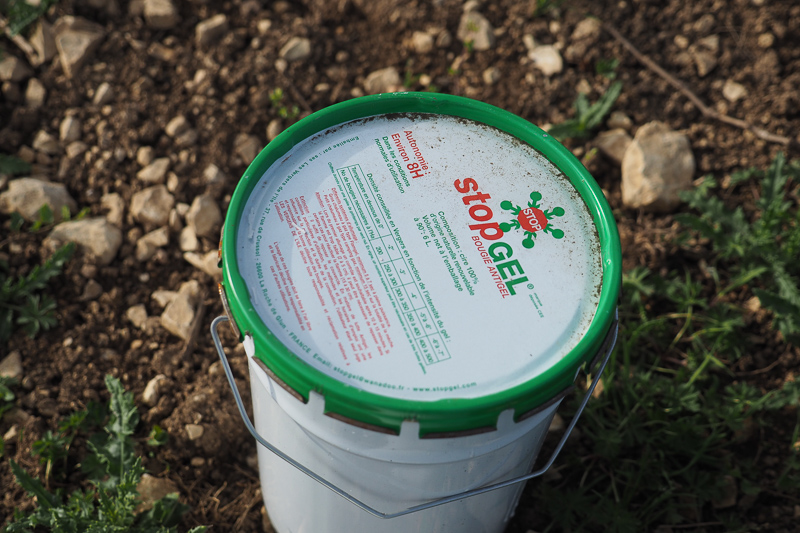
Heaters
The first is burning stuff in the vineyard to raise the temperature. The small smudge pots (known as bougies) are quite common, but it is an expensive method (around €8 a pot), and not very environmentally friendly. There is also an older variant on this theme: metal heaters that burn fuel, and these can get through quite a lot – one grower told me of using thousands of litres in a night. Generally speaking more smaller heat sources are better than fewer big ones.
Straw bales
There’s old school straw: these bales are set alight and burn all night. They aren’t too expensive, but they have a high carbon footprint. One way these work is by creating a cloud of smoke that then reduces the radiation of heat into the sky, thus helping prevent temperatures dipping too low.
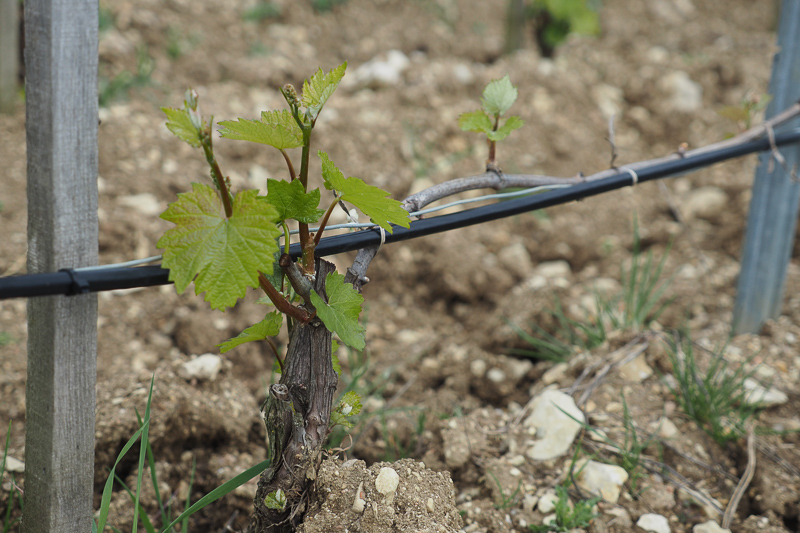
Electric heating wires
A fancy method that is quite expensive is to install heated wires, which run along the fruiting wire. This is in the Grand Cru Preuses vineyard (a plot owned by William Fevre), which is just too steep for bougies.

Baches
A somewhat exotic solution is to use a thermoprotective fabric (called baches) which is left over the vines until the frost risk has passed. Each sheet of fabric covers four rows of vines. This works well and has a low carbon footprint, but isn’t cheap and takes a long time to apply. The vines end up being a little advanced. For a while this solution was banned because it looks unattractive, but it is now allowed again. This method isn’t yet widely used in the region. I heard one report of a grower who got frosted under a bache.
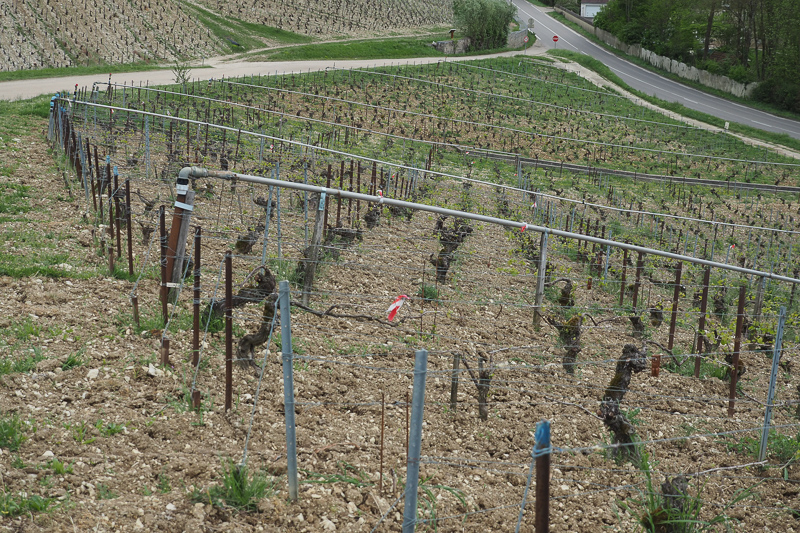
Water protection
Probably the most common protective measure is one that seems a little counterintuitive. It involves spraying water on the vines which then freezes and creates an ice layer over the buds. It is the latent heat released when the water freezes that protects the buds from frost damage, not the fact that the ice itself forms a protective cocoon (this is a widely held misconception). So for protection, the water needs to continually applied through the night while the temperatures are in the danger zone. It works, but there needs to be an adequate supply of water, some heavy-duty pumps, and miles of pipes. Many of these systems take water from the Sereine, but others have created dams specifically for this purpose (irrigation is not allowed here). The village of Beine, which has 605 hectares of vines, created an artificial lake in 1978 for frost fighting. It’s surface area is 15 hectares and it contains 450 000 cubic metres of water, which feed 40 km of pipes, protecting 100 hectares.
The final option for frost fighting is to use propellers. Strangely I haven’t seen a single one in Chablis, although I’ve been told there is at least one in the region. These work by moving air around, and rely on the existence of a slightly warmer layer of air above the freezing layer at ground level. Helicopters do the same thing. Their advantage is that they work, but their disadvantage is they are expensive, and they don’t work with advection frosts where there is no inversion layer.
Fighting frost: case study (2) Marlborough, New Zealand
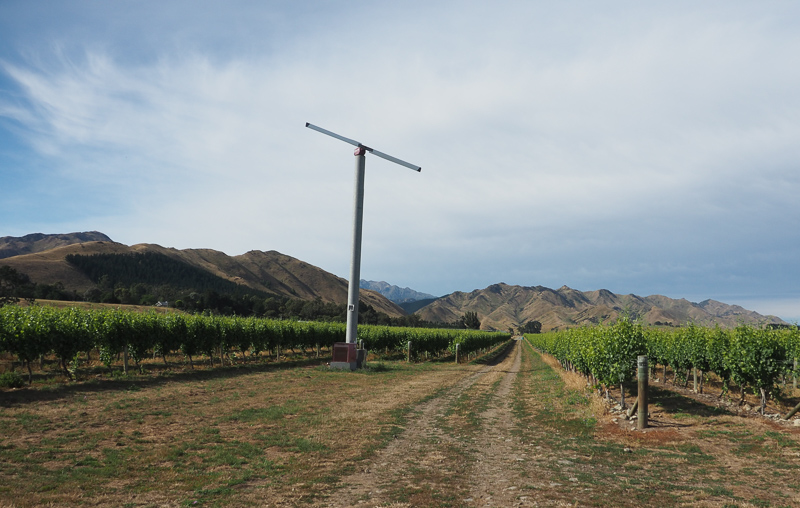
Marlborough, New Zealand’s largest wine region, has regular tussles with spring frosts. These seem to be getting worse over recent years. And they are also more of a problem with the more recently planted inland vineyard sites: as the value of vineyard land has increased there have been plantings further up the Wairau and the Waihopai Valleys in sites that previously would have been deemed too risky. Some sort of frost protection measure is essential.
One of the key features of the Marlborough landscape is the regular presence of tall propellor-bearing wind machines. These are elevated, and the idea is that they mix in the warmer air above the inversion layer with the colder air close to the ground. As long as there isn’t an advection frost this is an effective strategy. The big problem is the cost of buying the machines in the first place. Running costs in terms of diesel or propane are less than the costs of burners or smudge pots.
The other main technique is the use of helicopters. These are usually chartered from Wellington or Christchurch when the risk of frost is high. They arrive during daylight and fly around the vineyard area they are being paid to protect. Then, if as predicted, temperatures drop below freezing, they begin flying slowly over the vineyards, with the down draft of the rotors taking the warm air from the inversion layer and mixing it with the cold air at vine level. It’s an effective strategy in a radiation frost, but it’s expensive.
There are very few vineyards protected by water in the region. The large initial plantings at Ara in the Waihopai Valley are the exception. These vineyards have an overhead sprinkler irrigation system that can also be used for frost control, and there’s a pumphouse with some heavy duty pumps that can deliver the required water when it’s needed.

